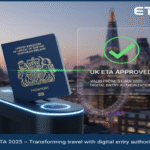Europe’s Borders Enter a New Era
Schengen Border Controls 2026 are set to bring the most significant updates in years — combining advanced digital monitoring with improved passenger flow. The European Union is preparing for smarter, safer, and faster cross-border movement through enhanced systems like ETIAS, EES (Entry/Exit System), and AI-assisted passport checks.
In this guide, we’ll break down every key update, what it means for travelers, and how the Schengen Area is reshaping border security without compromising the freedom of movement.
Why Schengen Borders Are Changing
The Schengen Zone — Europe’s travel freedom masterpiece — has long symbolized open movement. However, global security concerns, migration shifts, and digital transformation are driving the 2026 border policy overhaul.
The upcoming changes are designed to:
- Strengthen security and migration management.
- Implement biometric and AI-based verification.
- Integrate ETIAS & EES databases for smoother travel.
- Enable real-time entry/exit tracking for non-EU nationals.
These upgrades align with the EU’s Digital Schengen Strategy 2026, aimed at creating a smart border network across all member states.
What’s Changing in 2026: Key Schengen Border Controls 2026 Updates
1. AI-Based Border Screening
Starting mid-2026, Schengen border officers will use AI-supported facial recognition and predictive threat analysis tools to identify potential risks before travelers even arrive.
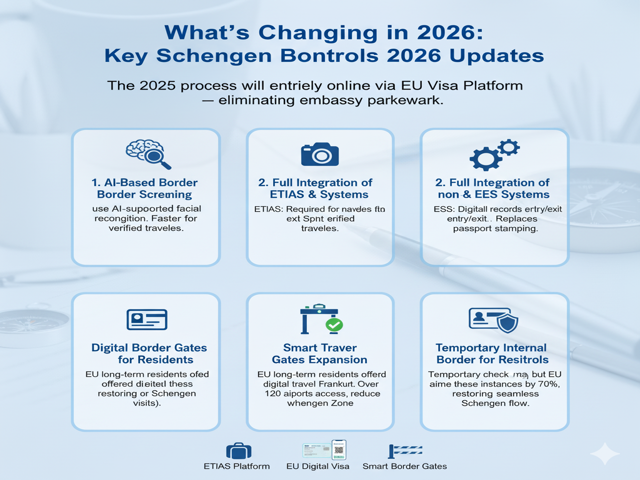
Benefit: Faster entry for verified travelers, stronger checks for flagged profiles.
2. Full Integration of ETIAS & EES Systems
Both the European Travel Information and Authorisation System (ETIAS) and Entry/Exit System (EES) will become fully functional in 2026.
Impact:
- ETIAS: Required for non-EU travelers entering the Schengen Area.
- EES: Digitally records entry and exit for short-term stays.
Together, these systems will replace traditional passport stamping — reducing queues and preventing overstays.
3. Smart Border Gates Expansion
Automated smart gates will become the new normal at major airports like Paris CDG, Frankfurt, Madrid-Barajas, and Amsterdam Schiphol.
Expected Expansion by 2026:
- Over 120 airports across the Schengen Zone.
- Integration with digital IDs and biometric verification.
4. Digital Travel Authorization for Residents
EU long-term residents and frequent travelers may be offered digital travel tokens — similar to ePassports — allowing pre-screened access across Schengen borders.
Goal: Reduce waiting times, especially for business and medical travelers.
5. Temporary Internal Border Controls
Some countries (like France and Germany) may retain temporary internal checks under emergency security clauses.
However, by 2026, the EU aims to reduce these instances by 70%, restoring a seamless Schengen flow.
Source: ETIAS Official EU Portal
What Travelers Should Prepare For Schengen Border Controls 2026
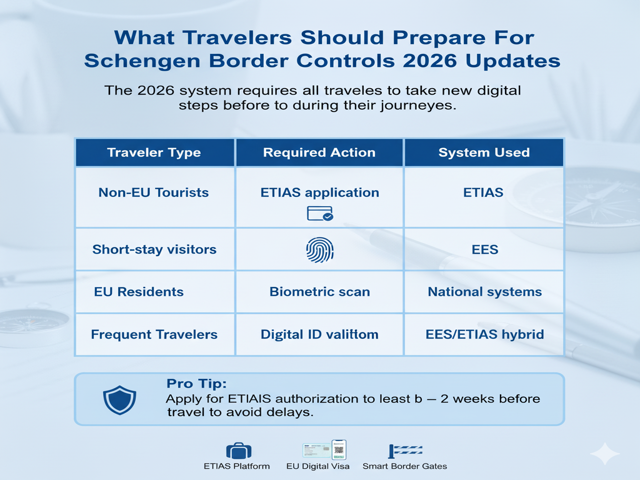
| Traveler Type | Required Action | System Used |
|---|---|---|
| Non-EU Tourists | ETIAS application | ETIAS |
| Short-stay visitors | Biometric scan | EES |
| EU Residents | Digital ID validation | National systems |
| Frequent Travelers | Pre-screened token use | EES/ETIAS hybrid |
Pro Tip: Apply for ETIAS authorization at least 1–2 weeks before travel to avoid delays.
How This Impacts Schengen Visa Holders
For those with Schengen short-stay or multiple-entry visas, the 2026 reforms mean:
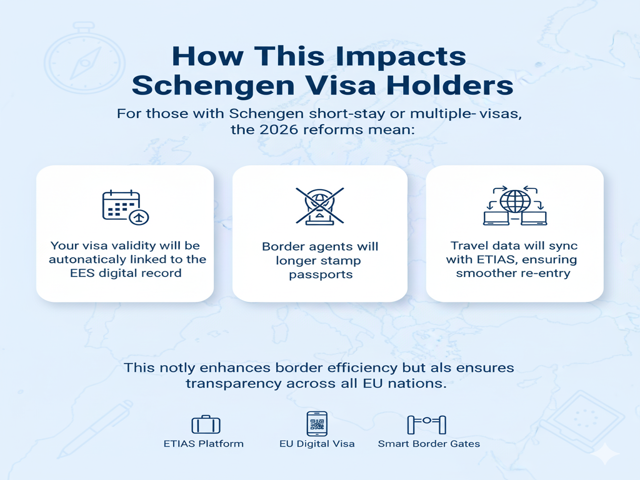
- Your visa validity will be automatically linked to the EES digital record.
- Border agents will no longer stamp passports.
- Travel data will sync with ETIAS, ensuring smoother re-entry.
This not only enhances border efficiency but also ensures transparency across all EU nations.
Countries Most Affected by the 2026 Border Policy
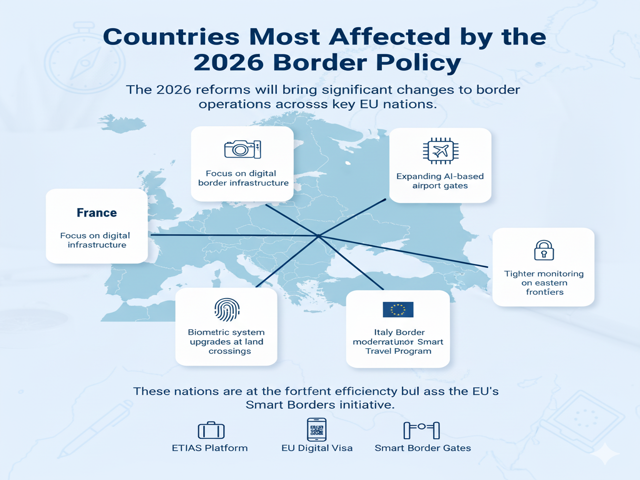
- France – Focus on digital border infrastructure.
- Germany – Expanding AI-based airport gates.
- Spain – Biometric system upgrades at land crossings.
- Italy – Border modernization under the EU Smart Travel Program.
- Poland & Hungary – Tighter monitoring on eastern frontiers.
Read Also: Schengen Visa Fees 2025 Increase Confirmed
FAQs – Schengen Border Controls 2026
1. When will the new Schengen border controls start?
They are expected to roll out gradually from mid to late 2026, depending on each country’s readiness.
2. Will travelers need a new visa after 2026?
No, but ETIAS authorization will be mandatory for non-EU nationals visiting Schengen countries.
3. Will border queues be longer during the transition?
Initially, yes — but once the digital systems stabilize, entry and exit will become faster than before.
4. Is biometric data stored permanently?
No, the EU ensures compliance with GDPR — traveler data will be stored temporarily for verification only.
5. Can internal borders within Schengen still close temporarily?
Yes, under security threats or health emergencies, internal checks may reappear briefly.
Expert Insight: What This Means for Future EU Travel
The Schengen Border Controls 2026 reforms mark the EU’s boldest step toward modernizing travel security.
It balances freedom and safety, using smart technologies to enhance traveler experience and reduce illegal crossings.
For global travelers, this signals the dawn of frictionless travel — a digital, paperless, and smarter Schengen area.
Advise Agent: A Safer, Smarter Schengen in 2026
By 2026, the Schengen Zone will evolve into a digitally managed border ecosystem.
With ETIAS, EES, and biometric technology working together, Europe aims to create safer, faster, and more transparent border control — without losing its essence of free movement.
Travelers should prepare early, stay updated with EU announcements, and ensure they comply with all digital entry requirements before their 2026 trips.



